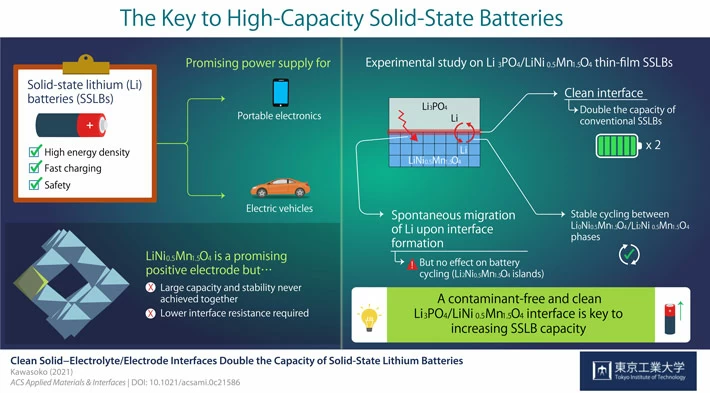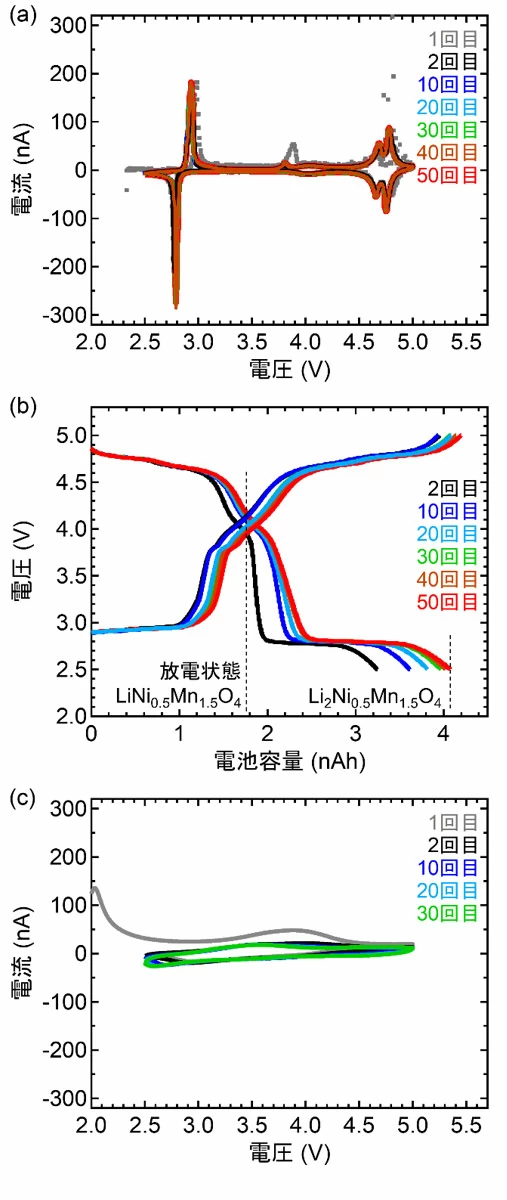

東工大:全固体電池の電池容量を2倍に:界面不純物制御(動画):
TIT: Double the capacity of all-solid-state batteries: Impurity control:
Tokyo Tech:将全固态电池的电池容量增加一倍:界面杂质控制
ーEVの航続距離増加や定置蓄電の拡大ー
2021.01.26
要点:
- 不純物を含まない清浄な界面を作製すると、全固体電池の電池容量が倍増することを発見
- 放射光X線回折測定により、界面近傍のリチウム分布や結晶状態を明らかにした
概要:
- 東京工業大学 物質理工学院 一杉教授、
- 東北大学の河底秀幸助教、
- 産業技術総合研究所の白澤主任研究員、
- 日本工業大学の白木將教授、
「電極と固体電解質が形成する界面における不純物制御」により、「全固体電池の容量を倍増させること」に成功した。
全固体電池の容量を倍増:
全固体電池の開発目標として、電池容量の増加と高出力化が挙げられる。
電池容量の増加は、機器の使用可能時間の延長につながる。
高出力化は、短時間での充電や、瞬間的な大きなパワーの取り出しを可能とする。
2倍の容量を実現:
不純物を含まない清浄な電極/電解質界面を作製すると、
リチウムの含有量が2倍になる。
- Li“2”Ni0.5Mn1.5O4を放電状態として、
- Li“0”Ni0.5Mn1.5O4を充電状態として、
- 使えることがわかった。
つまり、2倍の容量が実現したことを意味する。
放射光X線回折測定で検証:
さらに、界面形成時にリチウムイオンが自発的に移動し、界面近傍にLi2Ni0.5Mn1.5O4が不均一に存在することを、放射光X線回折測定により明らかにした。
本研究は、高容量型全固体電池の実現に向けて重要な一歩となるだけでなく、電極と固体電解質の界面におけるイオン輸送の学理構築にもつながる。
本研究成果:
1月25日(米国東部時間)に米国化学会誌「ACS Applied Materials and Interfaces」オンライン版に掲載された。
今後の展開:
今回、LiNi0.5Mn1.5O4全固体電池で、電池容量の倍増を実現した。
清浄な電極/電解質界面の新たな役割が浮き彫りとなった。
これまで、清浄な界面の作製により、
- 低界面抵抗の実現や、
- 高速充放電の実現に加え、
今回の電池容量倍増は、全固体電池の応用範囲の拡大につながる。
東工大ニュース | 東京工業大学
https://www.titech.ac.jp/news/2021/048762.html
Keeping a Clean Path: Doubling the Capacity of Solid-State Lithium Batteries
Published: January 26, 2021
Scientists at Tokyo Institute of Technology (Tokyo Tech),
Tohoku University,
National Institute of Advanced Industrial Science and Technology, and
Nippon Institute of Technology,
demonstrated by experiment that
a clean electrolyte/electrode interface is key to realizing high-capacity solid-state lithium batteries.
Their findings
could pave the way for improved battery designs with increased capacity, stability, and safety for both mobile devices and electric vehicles.
solid-state lithium batteries (SSLBs)
SSLBs comprise solid electrodes and a solid electrolyte that exchange lithium (Li) ions during charging and discharging.
Their higher energy density and safety make SSLBs very powerful sources.
However, there are still many technical challenges preventing SSLBs’ commercialization.
For the current study, researchers conducted a series of experiments and gained insight that could take SSLBs’ performance to the next level.
the capacity of SSLBs
Strikingly, the clean interface facilitated the intercalation and deintercalation of Li during charging and discharging of the SSLBs.
As a result, the capacity of SSLBs with a clean interface was twice that of conventional LNMO-based batteries.
Moreover, this study marked the first time stable reversible reactions were found between the L0NMO and L2NMO phases in SSLBs.
Aside from mobile devices,
SSLBs could find a home in electric cars, for which cost and battery durability act as major barriers for widespread commercialization.
The results of this study
provide important insight for future SSLB designs and pave the way for a transition away from fossil fuels and towards more ecofriendly ways of transportation. Keep an eye out for the advent of SSLBs!
Tokyo Tech News | Tokyo Institute of Technology
https://www.titech.ac.jp/english/news/2021/048815.html
Clean Solid–Electrolyte/Electrode Interfaces Double the Capacity of Solid-State Lithium Batteries
Solid-state lithium (Li) batteries
using spinel-oxide electrode materials such as LiNi0.5Mn1.5O4
are promising power supplies for mobile devices and electric vehicles.
Here, we demonstrate stable battery cycling between the Li0Ni0.5Mn1.5O4 and Li2Ni0.5Mn1.5O4 phases with working voltages of approximately 2.9 and 4.7 V versus Li/Li+ in solid-state Li batteries with contamination-free clean Li3PO4/LiNi0.5Mn1.5O4 interfaces.
This clean interface
has the effect of doubling the capacity of conventional battery cycling between the Li0Ni0.5Mn1.5O4 and Li1Ni0.5Mn1.5O4 phases.
We also investigated the structural changes between the Li0Ni0.5Mn1.5O4 and Li2Ni0.5Mn1.5O4 phases during battery cycling.
ACS Applied Materials & Interfaces
https://pubs.acs.org/doi/10.1021/acsami.0c21586
放射光X線回折とは
http://hep-www.px.tsukuba.ac.jp/TCHoU/LDPPD/event/slide151130/nishibori.pdf